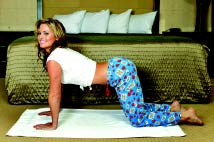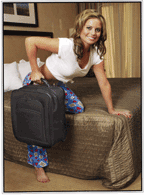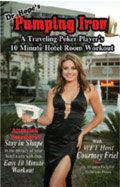|
The Math:
How You Too Can Be
a Mathter Poker Player

Math--I hate math. 2 times 2 is 4. (Or
is it 2 times 2 are 4? Is that a math question or an English question?
Hmmmm.) Now that I have us all sufficiently confused, let’s
move on. Why do we need to know math for poker? Ahaa! So we can
get the mathematical advantage by making the correct play when the
odds are in our favor.
This is how casinos make money; they have a mathematical
advantage on every game on the floor. While anyone on any given
day can beat the odds if they are lucky, over time the luck factor
disappears and the house will make what the math dictates. Some
games are better than others, but how do you know unless you know
the math?
Playing Baccarat, you will lose only about $1.25
per hundred dollars that you gamble (okay, so it’s really
$1.16 on the Banker and $1.32 on the Player, but you get the point--the
house has a small advantage in this game, unless you bet the tie.
Ouch!). On the other hand, you'll lose as much as $20 per hundred
that you gamble on some slot machines (depending on how those particular
machines are set. So the house has a monster advantage in this game).
So wouldn’t it be nice to have that advantage
when you played poker? Well, you can by doing the math. Here’s
how it works:
If the mathematical chances of you hitting a hand
are 4 to 1 and the pot is laying you 5 to 1, you’ve got a
mathematical advantage over time and you should make the call every
time you get the chance to. If, on the other hand, your hand is
4 to 1 and the pot is laying you only 2 to 1, then you have a mathematical
disadvantage over time and you should never call.
Pot Odds
First, you need to figure what kind of “price”
the pot is laying you. This is easy. Just add up all the money in
the pot and divide it by the amount of the bet you have to call.
For instance, let’s say the pot has $100 and you have to call
a $20 bet. 100/20=5. You are getting 5 to 1 pot odds.
If you think you have the best hand, it’s
a no brainer. However, if you think that you must improve to beat
your opponent, you have to figure out the mathematical chances of
doing that.
Hand Odds
In order to figure the odds of improving your hand,
you must first count your “outs.” An “out”
is a card that will turn your hand into the best hand.
For instance, let’s say you have pocket tens
and your opponent has pocket Aces. In order to beat him, you must
catch another ten. How many tens are left in the deck? Well, there
were four to begin with and you have two, so that leaves two left
in the deck. Therefore you have two outs.
Here’s the way a lot of players figure out
the odds: let’s say that after the flop you have two outs.
We can see what five cards are: the three on the board and the two
in your hand. This leaves forty seven cards that are unknown. So,
we have two chances in forty seven. Two cards will win for us and
forty five will lose for us. The odds are 45 to 2 or 22 ½
to 1 against hitting one of those cards on the Turn (about 11.25
to 1 with two cards coming--the turn and the river).
Let’s say you have a flush draw. There are
thirteen of your suit to start with and you know where four of them
are (two on the board and two in your hand). This leaves us nine
“outs” (13-4=9). That means we have nine chances in
our forty seven unknown cards, or one chance in 5.22, which would
make our odds 4.22 to 1 against hitting one of those cards on the
Turn (about 2.11 to 1 with two cards to come).
Wasn’t that fun? But is it accurate? Probably
close enough. (Did I mention that I hate the math?)
Alrightythen, that’s one way, but the real
mathematicians use this handy-dandy formula to compute the percent
and odds (and to melt the brains of mathematically challenged poker
players). With two cards to come, here’s how to figure out
the percentage probability:
Percent = 1-[(47- Outs) / 47) x (46-Outs) / 46)
]
Then they take that percent, magically turn it into
a whole number, and divide it into 100, then subtract 1. That gives
them the odds. Wasn’t that easy? (Did I mention that I hate
the math?)
With just one card to come, the formula is much
simpler: Percent = (46-Outs) / 46. Then, once again, we magically
turn that percent into a whole number (just move the decimal point
two places to the left) and divide it into 100 and subtract 1. What
could be easier? (Brain surgery, climbing Mount Everest, and learning
a foreign language in a week would be on my list.) Maybe it’s
not that bad. Let’s try it, shall we?
Here’s our two “Outer” example
from before:
Percent = 1 – [(47 – 2) / 47) x (46 – 2) / 46)]
= 1 – [(45 / 47) x (44 / 46)]
= 1 – [0.957 x 0.956]
= 1 – 0.914
= 0.086
= 8.6% chance with two cards to come (turn and river)
Now turn that % into odds:
100 / 8.6 = 11.63 – 1 = 10.63 to 1
Of course, if you round off to the one hundredth
instead of the one thousandth, it makes a big difference. You get
this:
Percent = 1 – [(47 – 2) / 47) x (46
– 2) / 46)]
= 1 – [(45 / 47) x (44 / 46)]
= 1 – [0.96 x 0.96] (Here’s where we did our rounding
off.)
= 1 – 0.92
= 0.08
= 8 % chance with two cards to come (turn and river)
Now turn that % into odds:
100 / 8 = 12.5 – 1 = 11.5 to 1
To make this easier, you can simply take a calculator,
ask your neighbor what the odds are (I’m sure they’ll
help), or use your Phone-a-Friend. (Did I mention that I hate the
math?)
Praise be to the Poker Gods! There is an easier way to compute the
percentage. I call it “The Double, Double.” Double,
double is less trouble! (That could make a nice little ditty. Let’s
see…Double double, ditty ditty, dom ditty do; I’m hers,
she’s mine, wedding bells are going to chime—hmmm, maybe
that’s been used before—never mind.)
Here’s how “Double, double” works:
take your number of outs and double it. If you have 2 outs, your
percent becomes 4. 5 outs would be 10 percent. Man, that was easy.
This gives you the approximate percent you will hit on the next
card.
In order for you to figure out the percentage with
two cards to come, simply double again. Hence the Double, double
ditty. (Cool, something I can do without using my Phone-a-Friend.)
To reiterate (I love repeating myself and using
the word reiterate. I love repeating myself and using the word reiterate.)
Let’s try this on our two “outer”:
2 times 2 is 4. (are 4? Oh no, not that English/Math question again.)
So you’re at 4% to hit on the next card. With two cards to
come, you double again. You have an 8% chance to hit your card with
two cards coming.
Double, double: easy to do, easy to remember. The
bummer is you still have to convert that into odds. To get your
odds, take that percent number and divide it into 100 and subtract
1. For our example, you get 12 to 1 with two cards to come or 24
to 1 with one card.
Believe me, this is way close enough for you to
make your determination. If you had a flush draw, you would be 36%
with two cards to come or 18% with one card to come. So you would
be 2.25 to 1 with two cards to come, or 4 ½ to 1 with one.
A lot of you folks out there in the poker world
can do this easily in your heads. Good for you. I’m sorry,
but I’m not that smart. So what did I do? I cheated; I memorized
them.
Here’s a handy-dandy little chart:
Outs |
Odds with two cards
to come; this is the column I memorized. |
Then I just double
it for one card |
2 |
12
to 1 |
24
to 1 |
3 |
7
to 1 |
14
to 1 |
4 |
5
to 1 |
10
to 1 |
5 |
4
to 1 |
ETC. |
6 |
3.2
to 1 |
|
7 |
2.6
to 1 |
|
8 |
2.2
to 1 |
|
9 |
1.9
to 1 |
|
10 |
1.6
to 1 |
|
11 |
1.4
to 1 |
|
12 |
1.2
to 1 |
|
13 |
1.1
to 1 |
|
14 |
.95
to 1 |
|
15 |
.85
to 1 |
|
16 |
.75
to 1 |
|
17 |
.66
to 1 |
|
The first column is your number of outs, the second
the odds with two cards to come, and the third is the odds with
one card to come. (Notice that the third column is just the second
doubled.)
Double, double is less trouble! So remember to take
your hand odds and see if the pot odds are giving you the right
price to call. But is that all you have to consider? No! There’s
implied odds too.
Implied Odds
Implied odds are like the second cousin to pot odds,
except they don’t come from Tennessee and they have a few
more teeth. Implied odds consider the likelihood of you making more
money on future rounds of betting based on the probable actions
of your opponents and the money in their stacks. So, ask yourself,
“What am I likely to extract from these players if I make
my hand?” Then add that to the pot odds and see what you get.
For instance: A man, a priest, and a Jewish rabbi
walk into a bar…wait, I think I was looking at the wrong notes,
er, here it is:
Let’s say you’re playing 5-10 No-Limit
Hold’em. Four players limped into the pot before the flop.
You have A 5 of spades. The flop has two spades, giving you the
nut flush draw. There is $45 in the pot. The big blind bets $30.
You know that the hand odds against improving on
the next card are about 4 to 1. There is now $75 in the pot. You
are only getting about 1.7 to 1 on your call. So the pot odds dictate
a fold.
But what are the people behind you most likely to
do based on their calling patterns? If you call, there’s going
to be $105 in the pot. The person next to act is now getting 3.5
to 1. Will that entice him into the pot? From what you know about
him, you think that he will likely call.
So you call and he calls the $30, making it $135.
Now the last person to act is getting 5.5 to 1. If that person is
on a flush or a straight draw, he already has the right pot odds
to call. He does. If this happens, you're getting 6.5 to 1, a great
price to try and make your draw.
Before the Flop Odds
Here’s some other important stuff that you
should just memorize:
1. A pair vs. two lower cards: The pair is about
a 5-1 favorite.
2. A higher pair vs. lower pair: The higher pair is a 4.5-1 favorite.
3. A pair vs. one high card and one low: The pair is a 2.5-1 favorite.
4. Two higher cards vs. two lower cards: The high cards are a 1.7-1
favorite.
5. A pair vs. two higher cards: The pair is a slight favorite, about
55%. Now that your brain is melting out your ears, my job here is
done.
So what have we learned here today?
1. Know the mathematical odds of a pot.
2. Know the pot odds and implied odds so you can judge whether to
call or not.
3. Know where the cocktail waitress is so she can clean up your
brains, which melted out of your ears already. (By the way she’s
in the bar with the man, the priest, and Jewish rabbi.)
In my book, there are a lot of skills more important
than the math (and, hey, this is my book!) Some are hand selection,
when to value bet, reading your opponents, and knowing how much
to overtip the cocktail waitress for cleaning up all those melted
brains.
Be sure and read my next article, “Trusting
Your Gut.”
So until next time, remember
the number one thing in poker is to have fun and enjoy it. It’s
not whether you win or lose that counts; it’s whether
I win or lose.
C’ya
Dr. Hope, J.A.P.D
(Just A Pretend Doctor)
This
article was taken from a book designed to keep poker players in shape
while they are on the road. This easy 10 minute hotel room
workout has helped some world-class poker players stay in shape.
Dr. Hope, for one. Anny Duke told Dr. Hope that Eric
Seidel uses this workout whenever he is on the road. T.J.
Cloutier told Dr. Hope, "There's some good stuff in that book."
The name of the book is:
Pumping Iron: A Traveling Poker Player’s 10 Minute Hotel Room
Workout. Here are some pictures from
it:



Here's
what people are saying about this book:
Absolutely the best book I've ever read in my whole
life! It's hilarious and well written.-- Dr. Hope's mom
If you travel you need this book! You should buy at least one copy
- no wait- at least three copies, of this fantastic innovative
book! --Dr. Hope's publisher

Want
it?
CLICK
HERE Help
support this site by
purchasing
your copy of
Dr.
Hope’s
Pumping
Iron: A Traveling Poker Player’s
10 Minute Hotel Room Workout today!
|